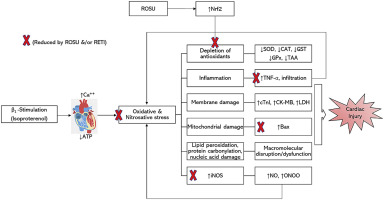当前位置:
X-MOL 学术
›
Chem. Biol. Interact.
›
论文详情
Our official English website, www.x-mol.net, welcomes your
feedback! (Note: you will need to create a separate account there.)
Rosuvastatin and retinoic acid may act as 'pleiotropic agents' against β-adrenergic agonist-induced acute myocardial injury through modulation of multiple signalling pathways.
Chemico-Biological Interactions ( IF 4.7 ) Pub Date : 2020-01-30 , DOI: 10.1016/j.cbi.2020.108970 Faheem Sultan 1 , Rajdeep Kaur 1 , Arshad Hussain Mir 1 , Ishfaq Maqbool 2 , Milindmitra Lonare 1 , Digvijay Singh 1 , Satyavan Rampal 1 , Javeed Ahmad Dar 2
Chemico-Biological Interactions ( IF 4.7 ) Pub Date : 2020-01-30 , DOI: 10.1016/j.cbi.2020.108970 Faheem Sultan 1 , Rajdeep Kaur 1 , Arshad Hussain Mir 1 , Ishfaq Maqbool 2 , Milindmitra Lonare 1 , Digvijay Singh 1 , Satyavan Rampal 1 , Javeed Ahmad Dar 2
Affiliation

|
Cardiovascular disorders constitute the principal cause of deaths worldwide and will continue as the major disease-burden by the year 2060. A significant proportion of heart failures occur because of use and misuse of drugs and most of the investigational agents fail to achieve any clinical relevance. Here, we investigated rosuvastatin and retinoic acid for their "pharmacological pleiotropy" against high dose β-adrenergic agonist (isoproterenol)-induced acute myocardial insult. Rats were pretreated with rosuvastatin and/or retinoic acid for seven days and the myocardial injury was induced by administering isoproterenol on the seventh and eighth day. After induction, rats were anaesthetized for electrocardiography, then sacrificed and different samples were collected/stored for various downstream assays. Myocardial injury with isoproterenol resulted in increased cardiac mass, decreased R-wave amplitude, increased QRS and QT durations; elevated levels of cardiac markers like cTnI, CK-MB, ALT and AST; increased lipid peroxidation, protein carbonylation and tissue nitric oxide levels; decreased endogenous antioxidants like SOD, CAT, GR, GST, GPx and total antioxidant activity; increased inflammatory markers like TNF-α and IL-6; decreased the mRNA expression of Nrf2 and Bcl-2; increased the mRNA expression of Bax, eNOS and iNOS genes. Pretreatment with rosuvastatin and/or retinoic acid mitigated many of the above biochemical and pathological alterations. Our results demonstrate that rosuvastatin and retinoic acid exert cardioprotective effects and may act as potential agents in the prevention of β-adrenergic agonist-induced acute myocardial injury in rats. Cardioprotective potential of rosuvastatin and retinoic acid could be attributed to their influence on the redox pathways, immunomodulation, membrane stability, Nrf2 preservation, iNOS and Bax expression levels. Thus, they may act directly or indirectly at various steps, the breakpoints, in the pathophysiological cascade responsible for cardiac injury. Our study gives insights about the pharmacological pleiotropism of rosuvastatin and retinoic acid.
中文翻译:

罗苏伐他汀和维甲酸可通过调节多种信号通路,作为对抗β-肾上腺素能激动剂引起的急性心肌损伤的“多效剂”。
心血管疾病是全球范围内主要的死亡原因,并将继续作为主要疾病负担,到2060年。很大一部分心力衰竭是由于使用和滥用药物而引起的,大多数研究药物未能达到任何临床意义。在这里,我们研究了瑞舒伐他汀和维甲酸对大剂量β-肾上腺素能激动剂(异丙肾上腺素)引起的急性心肌损伤的“药理性多效性”。用瑞舒伐他汀和/或视黄酸预处理大鼠7天,在第7天和第8天给予异丙肾上腺素诱导心肌损伤。诱导后,将大鼠麻醉以进行心电图检查,然后处死并收集/保存不同的样品用于各种下游测定。异丙肾上腺素对心肌的伤害导致心脏质量增加,R波振幅降低,QRS和QT持续时间增加;cTnI,CK-MB,ALT和AST等心脏标志物水平升高;增加脂质过氧化,蛋白质羰基化和组织一氧化氮水平;减少了内源性抗氧化剂,如SOD,CAT,GR,GST,GPx和总抗氧化剂活性;炎症标记物如TNF-α和IL-6增加;降低Nrf2和Bcl-2的mRNA表达;增加了Bax,eNOS和iNOS基因的mRNA表达。用瑞舒伐他汀和/或视黄酸预处理可减轻上述许多生化和病理改变。我们的结果表明,瑞舒伐他汀和维甲酸具有心脏保护作用,并可能在预防β-肾上腺素能激动剂引起的大鼠急性心肌损伤中起潜在作用。罗苏伐他汀和视黄酸的心脏保护潜力可能归因于它们对氧化还原途径,免疫调节,膜稳定性,Nrf2保存,iNOS和Bax表达水平的影响。因此,它们可以在负责心脏损伤的病理生理级联中的各个步骤,即断点处直接或间接起作用。我们的研究提供了有关瑞舒伐他汀和维甲酸的药理多效性的见解。iNOS和Bax表达水平。因此,它们可以在负责心脏损伤的病理生理级联中的各个步骤,即断点处直接或间接起作用。我们的研究提供了有关瑞舒伐他汀和维甲酸的药理多效性的见解。iNOS和Bax表达水平。因此,它们可以在负责心脏损伤的病理生理级联中的各个步骤,即断点处直接或间接起作用。我们的研究提供了有关瑞舒伐他汀和维甲酸的药理多效性的见解。
更新日期:2020-01-31
中文翻译:

罗苏伐他汀和维甲酸可通过调节多种信号通路,作为对抗β-肾上腺素能激动剂引起的急性心肌损伤的“多效剂”。
心血管疾病是全球范围内主要的死亡原因,并将继续作为主要疾病负担,到2060年。很大一部分心力衰竭是由于使用和滥用药物而引起的,大多数研究药物未能达到任何临床意义。在这里,我们研究了瑞舒伐他汀和维甲酸对大剂量β-肾上腺素能激动剂(异丙肾上腺素)引起的急性心肌损伤的“药理性多效性”。用瑞舒伐他汀和/或视黄酸预处理大鼠7天,在第7天和第8天给予异丙肾上腺素诱导心肌损伤。诱导后,将大鼠麻醉以进行心电图检查,然后处死并收集/保存不同的样品用于各种下游测定。异丙肾上腺素对心肌的伤害导致心脏质量增加,R波振幅降低,QRS和QT持续时间增加;cTnI,CK-MB,ALT和AST等心脏标志物水平升高;增加脂质过氧化,蛋白质羰基化和组织一氧化氮水平;减少了内源性抗氧化剂,如SOD,CAT,GR,GST,GPx和总抗氧化剂活性;炎症标记物如TNF-α和IL-6增加;降低Nrf2和Bcl-2的mRNA表达;增加了Bax,eNOS和iNOS基因的mRNA表达。用瑞舒伐他汀和/或视黄酸预处理可减轻上述许多生化和病理改变。我们的结果表明,瑞舒伐他汀和维甲酸具有心脏保护作用,并可能在预防β-肾上腺素能激动剂引起的大鼠急性心肌损伤中起潜在作用。罗苏伐他汀和视黄酸的心脏保护潜力可能归因于它们对氧化还原途径,免疫调节,膜稳定性,Nrf2保存,iNOS和Bax表达水平的影响。因此,它们可以在负责心脏损伤的病理生理级联中的各个步骤,即断点处直接或间接起作用。我们的研究提供了有关瑞舒伐他汀和维甲酸的药理多效性的见解。iNOS和Bax表达水平。因此,它们可以在负责心脏损伤的病理生理级联中的各个步骤,即断点处直接或间接起作用。我们的研究提供了有关瑞舒伐他汀和维甲酸的药理多效性的见解。iNOS和Bax表达水平。因此,它们可以在负责心脏损伤的病理生理级联中的各个步骤,即断点处直接或间接起作用。我们的研究提供了有关瑞舒伐他汀和维甲酸的药理多效性的见解。











































 京公网安备 11010802027423号
京公网安备 11010802027423号